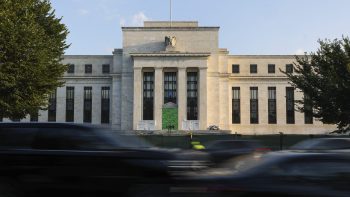Federal Reserve Chairman Ben Bernanke will tell Congress this week how the Fed plans to diffuse the $1 trillion bomb ticking away inside the banks. Did I mention that the Fed assembled this bomb in the first place?
I am, of course, referring to the $1 trillion the Fed created out of nothing and pumped into the banking system the past two years. That money is sitting on bank balance sheets as “excess reserves.” If all that money was injected into the economy in the form of loans, inflation would explode, and the dollar would quickly be worthless.
But the Fed has a plan. Under a law passed in the 2008, the Fed can pay banks interest on those excess reserves — whatever rate it wishes. According to the Wall Street Journal, the Fed intends to jack up that interest rate so banks have no incentive to lend it:
…looking ahead to when the economy is strong enough to warrant tightening credit, officials have been discussing for months which financial levers to pull, when to start and how best to communicate their intent.
When the Fed is ready to tap the brakes, it plans to raise the rate paid on excess reserves, according to Fed officials in interviews and recent speeches. The higher rate would entice banks to tie up money they otherwise might lend to customers or other banks.
Looking ahead to when the economy is strong enough to warrant tightening credit. I’m sorry, I must have missed something. When was credit loosened? The only entity banks have been lending to is the government.
So the Fed created all of this money and poured it into the banking system with the expectation that banks would eventually lend it to businesses again. Instead, the banks kept the money, tightened credit and found ways to make money off of it without lending it to business. Oops.
And now that the money’s out there, the Fed’s strategy is to prevent banks from lending it at all costs. If it floods the economy, inflation will go sky-high. When in this equation do businesses actually get access to credit? Here’s an excellent description of what’s going on here from Goldseek:
One could liken this situation to that of a loaded revolver… In essence, the Federal Reserve dealt with those mischievous risk-takers at the banks who had nearly destroyed the financial world by handing to them a loaded revolver that was pressed against the heads of all the nation’s savers, investors and retirees. A revolver that could destroy most of the value of your personal savings. Then the Fed said “Please don’t pull the trigger! We will create however much money is needed and pay it into your personal bonus pools, just so you won’t pull the trigger on that revolver we just handed to you.”
The American people and the economy are the hostages, and the banks have the gun. Now, they can say to the Fed: Hey, we want 10% interest on these reserves, or the public gets it! No, wait a minute, make that 20%! More from Clusterstock:
Of course, in the process of increasing interest paid on reserves, the Fed will be paying banks even more not to lend. In the process, it will be giving banks yet another way to take nearly free money from the taxpayer and give it back to the government at a higher rate–and then pocket the difference.
All of this underscores the main message of the government’s bailout policies, which has been so glaringly evident over the past year: It’s a great time to be a banker.
In the meantime, businesses that can’t get access to credit continue to fail. You could argue this is some sort of Darwinian event for the economy, that only the strongest businesses should survive.
But Darwin’s theory sure doesn’t seem to apply to the banks.
There’s a lot happening in the world. Through it all, Marketplace is here for you.
You rely on Marketplace to break down the world’s events and tell you how it affects you in a fact-based, approachable way. We rely on your financial support to keep making that possible.
Your donation today powers the independent journalism that you rely on. For just $5/month, you can help sustain Marketplace so we can keep reporting on the things that matter to you.


















